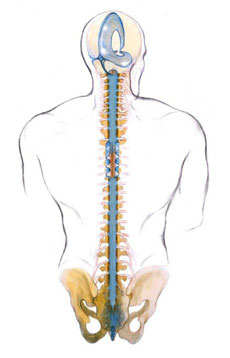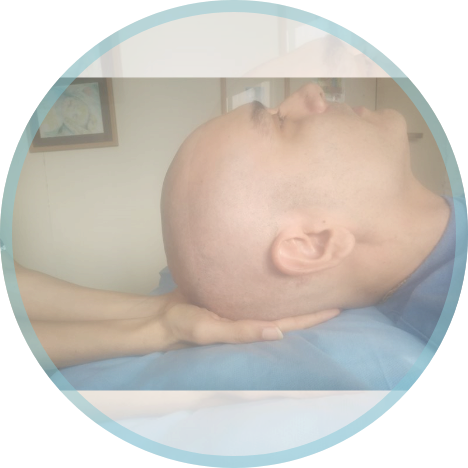Anatomy & Physiology of the Craniosacral System
The craniosacral system is an involuntary system in our body, like the respiratory, circulatory, digestive systems. It supports the autonomic nervous system of the body as well as all other systems. It is housed within the central nervous system structures.
It starts at the head (Cranium) and continues till the tail bone (Sacrum and Coccyx), hence the term cranio-sacral system / therapy.
Blood circulation from the heart goes to the brain, and within the deeper structures of the brain are small filtering organs called the Choroid Plexus. Here, the oxygenated blood gets filtered into a light yellowish fluid called Cerebrospinal Fluid (CSF). This fluid is produced in 4 ventricles in the brain and is then distributed down the spinal canal, all the way to the end of the spinal cord. It is also continuously being reabsorbed into the venous blood stream, through tiny veins and blood vessels that exit from dural membranes that line the inner surface of the skull and spine. The CSF gets reabsorbed into the blood.

The blood goes back to the heart and lungs for oxygenation and then oxygenated blood comes back to the brain and is filtered and produced as CSF in the ventricles and distribution starts again. This is the circulation of CSF.
The filtering of oxygenated blood, the production of CSF in the ventricles, its distribution down the spinal canal and its re-absorption into the venous blood stream is called the Craniosacral System.
Functions of the Craniosacral System and Qualities of CSF:
- The circulation of CSF bathes and nourishes all the nerves, cells, tissues, membranes and fibers in the brain and spinal cord.
- CSF is a slightly transparent and light yellowish fluid. There is approximately 150ml of CSF in the brain and spinal cavity at any one point and its total volume is replaced every 3-4 hrs.
- CSF is rich in essential minerals like magnesium, chloride and amino acids. It maintains the chemical balance of the Central Nervous System (CNS). All the critical functions of the CNS are dependent on the proper supply of this fluid. Any deficiency in production of CSF will lead to malnutrition of the brain.
- Waste products are rinsed from the CNS by the steady flow and re-absorption of the CSF, thereby preventing toxic build up in the central nervous system structures.
- Through the blood small quantities of CSF is distributed to the entire body and all its cell structures providing it the essential minerals like amino acids which are key components for healthy cellular building.
- CSF acts as a shock absorber for the brain and spinal cord, protecting it from external impacts and injuries.
- CSF is the highest known element in the body. It is often called the liquid light, because not only can it absorb light particles, but is also rich in potency and healing properties. It is like the life giving sap in a tree; a battery fluid of the body.
- The tidal motion of the CSF is described as a longitudinal fluctuation because it moves up and down the length of the body. When CSF rises up in the body it is called the inhalation phase, a sense of welling up, expansion. When the CSF recedes down the body, its known as the exhalation phase, a sense of narrowing inwards, emptying. This fluctuation motion occurs on an average 10 times every minute.
A healthy unrestricted flow of CSF is essential to the health of our nervous system and since the nervous system is the control house of all other systems and functions of the body, the healthy and unrestricted flow of CSF is also directly related to the entire health of our body.
In terms of quality, the cerebrospinal fluid is the highest known element in the body. It fluctuates 100 times in 10 minutes. 10 times a minute, every cell in the body has been massaged – the whole spine, the whole cord, the cells, nerves, muscles and everything else. Dr. Rollin Becker D.O
